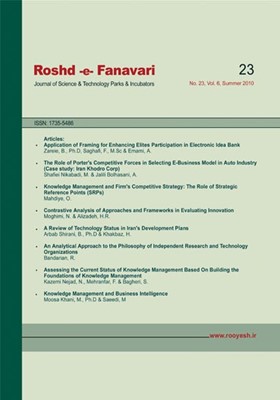-
-
List of Articles
-
Open Access Article
1 - Application of Framing for Enhancing Elites Participation in Electronic Idea Bank
Behrooz Zarei Fateme Saghafi Amir Emami -
Open Access Article
2 - The role of Porters 5 Competitive Forces in selecting e-business model in auto industry (Case study: Iran Khodro)
Mohsen Shafiei Nik Abadi Auzam Jalili bolhasani -
Open Access Article
3 - Knowledge Management and Firm's Competitive Strategy:The Role of Strategic Reference Points (SRPs)
Omid Mahdiye -
Open Access Article
4 - Contrastive Analysis of Approaches and Frameworks in Evaluating Innovation
Seyed Nooroddin Daronkolaei Hoseynreza Alizadeh Vlokolaei -
Open Access Article
5 - A Review of Technology Status in Iran's Development Plans
Behrooz Arbab Shirani Hasan KIhakbaz -
Open Access Article
6 - An Analytical Approach to the Philosophy of Independent Research and Technology Organizations
-
Open Access Article
7 - Assessing the Current Status of Knowledge Management Based On Building the Foundations of Knowledge Management
Noshin Kazemi nejad Faezeh Mehranfar Seyede Saba Bagheri -
Open Access Article
8 - Knowledge Management and Business Intelligence
Mohammad reza Mosa Khani Mahshid Saeidi
-
The rights to this website are owned by the Raimag Press Management System.
Copyright © 2017-2025







